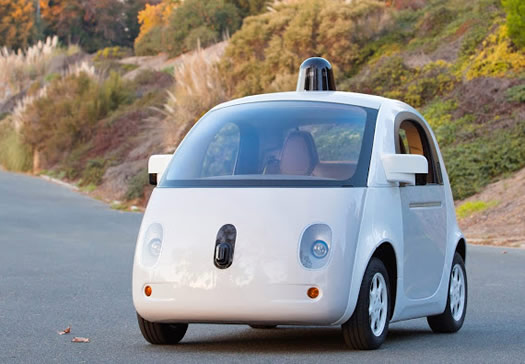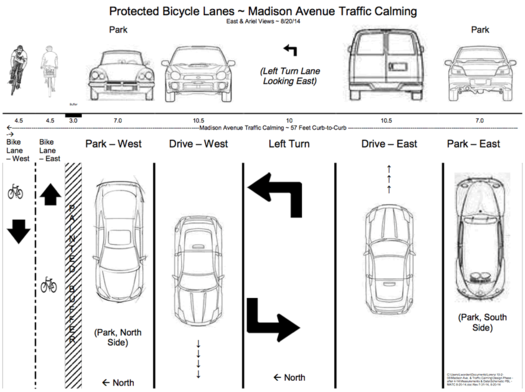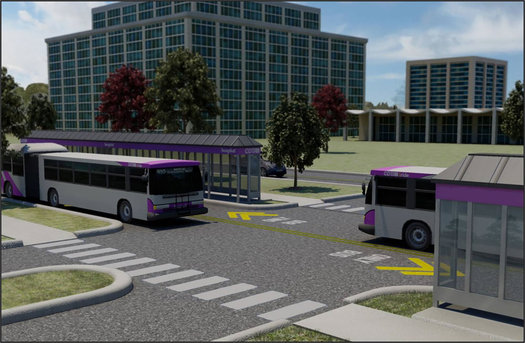Planning for how we'll all get around the Capital Region in the future

If our future overlords will be self-driving vehicles, it's probably a good idea to have a plan fo them. (If only so we can properly welcome them.) / photo: Google
A bit of follow-up to that discussion about trends that are shaping the way people get around the Capital Region: The Capital District Transportation Committee has a couple of public meetings this week to go over the draft version of its New Visions 2040 Plan -- this is the map (of sorts) for thinking and planning all sorts of regional transportation stuff, including roads, bridges, traffic congestion, CDTA, bike lanes, car sharing, road diets, even stuff like self-driving cars.
The meetings are:
+ Tuesday, June 16 at the Empire State Plaza (Meeting Room 6, Concourse Level) from 6:30-8:30 pm
+ Thursday, June 18 at Niskayuna Town Hall from 6:30-8:30 pm
The full draft plan is online if you'd like to have a look (there's also an executive summary and listing of key recommendations.) If you're curious about any of the topics mentioned above, you'll probably find at least a few interesting bits.
After a quick read through, here are a handful of things that caught our eye:
Not making roads bigger
The plan mentions not supporting increased road capacity, in large part because people have driving less. It also specifically mentions not looking to add capacity on the Northway (p. 91):
Adding capacity to the Northway can be expected to result in higher traffic volumes and could generally be expected to result in conditions similar to those which exist today. In addition, widening would not prevent delays that result from incidents such as bad weather conditions, traffic crashes and vehicle breakdowns. Adding considerable capacity in one corridor would also re-concentrate traffic into the peak period, putting severe traffic pressure on all intersecting roads and expressways that are not widened. In addition, widening the Northway would be prohibitively expensive and would provide benefits for only short periods in peak periods in one direction. Finally, people are driving less, moving back to the cities, and obtaining fewer drivers licenses; and self-driving vehicles will likely decrease congestion and crashes. This means that adding physical capacity to the Northway would not be a wise long term investment.
Among the suggestions for possibly managing congestion on the Northway, especially around the Twin Bridges: "active traffic management" techniques such as variable speed limit displays that could help smooth out flow based on current conditions.

A schematic of potential protected bike lane on Madison Ave in Albany created last year by Lorenz Worden of the Albany Bicycle Coaltion.
Protected bike lanes
The plan calls for promoting the development of protected bike lanes (p. 7):
Many bicycle riders do not feel safe in a shared use travel lane, and many vehicle drivers are not considerate of bicycle riders in a shared use travel lane. In order to provide a safer environment to ride and to encourage more bicycle riders, we need to construct more of these bicycles lanes.
There's already a push for these sorts of bike lanes in Albany, so it will be interesting to see if municipalities start building them.
It also calls for completing bike trails projects such as connector between the Albany County Rail Trail and the Corning Preserve Trail.
Transit-only lanes

A rendering of a proposed transit-only lane at the Harriman State Office Campus in Albany. / image: CDTA
The proposed bus rapid transit line that would run along the Western/Washington corridor in Albany includes a dedicated transit-only lane through the Harriman office campus and the UAlbany uptown campus. And the New Visions 2040 plan calls for encouraging more of these types of lanes (p. 67):
These systems, in combination with Transit Oriented Development, create communities that on a regional scale preserve open space and reduce the need for travel by car. The "permanent" nature of guideways contributes to greater development along a corridor than that stimulated by bus service in mixed traffic. Transit Oriented Development is generally defined as mixed-use development (mixing residential, retail, office, open space, and public uses) within walking distance of a transit stop that encourages travel on foot or by public transportation instead of by car.
On this front, the New Visions plan overlaps with the current rezoning effort in Albany, which also includes transit-oriented development as one of its aims.
(Also: "Use established national criteria to identify transit corridors that may have the potential to support streetcar or light rail transit. Monitor and re-evaluate these corridors at regular intervals.")
Paying for transit
The plan looks at potential sources of new or increased funding for transit programs in the Capital Region. Among them: fare increases and new types of taxes such as congestion pricing (p. 78). And it floats this idea (p. 79):
Most tenable in the Capital Region may be a novel funding source which directly connects an incremental tax increase to a clear benefit that transit is uniquely capable of providing. A notable example of this is the use in Pittsburg's Allegheny County (Pittsburgh Pennsylvania) of a pouring fee on alcoholic beverages that directs the funds to public transit. Research indicates this tax generates $43M annually. In the Capital Region, the growing craft beverage movement could suggest a new funding source. By steering the tax proceeds of such a potential fee to transit, and portion to safe rides programs, evening and nighttime transit service could be increased in order to reduce the potential for driving under the influence (DUI) dangers.
That one sounds like it would be a tough sell, especially since the craft beverage industry is just getting a foothold here.
Self-driving vehicles
When we talked with CDTC executive director Mike Franchini back in March, it sounded like he had been thinking a lot about self-driving vehicles. And the tech is prominently mentioned in the report. One clip (p. 48):
Totally automated vehicles (self-driving cars) until recently were considered by many a concept for the distant future. Demonstrations by Google of a totally automated vehicle have made the full development of this technology plausible, although the timeline is uncertain. However, incremental improvements in vehicle automation are expected on the short term horizon. Because the impacts of automated vehicles have the potential to be dramatic, it would not be responsible to ignore them in a plan with a horizon year of 2040.
The plan goes on to speculate about the potential effects of the tech on fronts such as congestion, safety, transit, freight, roadway design, and privacy.
Hi there. Comments have been closed for this item. Still have something to say? Contact us.
Comments
Here's George Jetson!
... said mg on Jun 16, 2015 at 11:13 PM | link
Re: self-driving cars
Just imagine one of these matchboxes hit a deer at 60 mph
... said Lu on Jun 17, 2015 at 8:24 AM | link